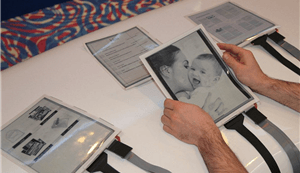File That!
on

A flexible tablet design created by Queens University (UK) in collaboration with Intel Labs and Plastic Logic offers innovative control features, according to the development team. The PaperTab tablet is built around a flexible 10.7-inch plastic display developed by Plastic Logic (Cambridge, England) and is powered by a Core i5 processor. Early prototypes are based on Plastic Logic's monochrome display.
The PaperTab project was developed at the Human Media Lab at Queen's University and Plastic Logic and encompasses various use and control schemes based on the flexibility of the display. For example, you can send a photo by email with the PaperTab by tapping one PaperTab showing a draft email and another PaperTab showing a photo. The photo is then automatically attached to the draft email. The email itself can be sent either by placing the PaperTab in an out tray or by bending the top corner of the display.
The screen icons work in a manner similar to a computer desktop. When picked up or touched, a PaperTab switches back to a full screen page view, just like opening a window on a computer. A larger drawing or display surface can be created by placing two or more PaperTabs side by side. In this way PaperTabs emulate the handling of multiple sheets of paper by combining thin-film display, thin-film input and computing technologies.


Discussion (0 comments)